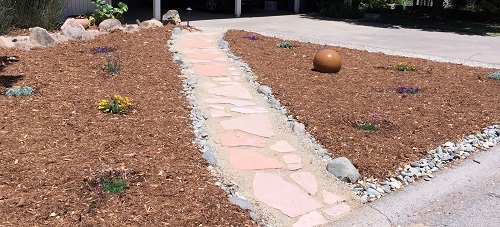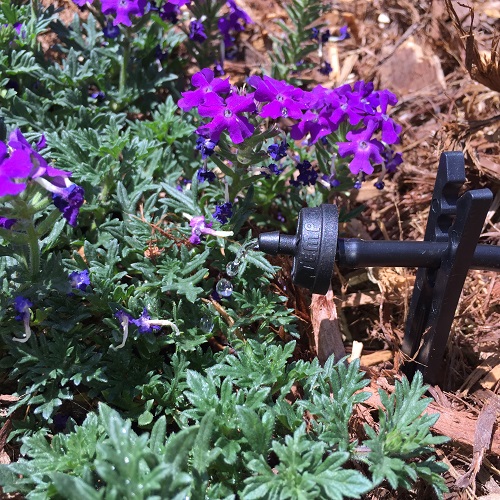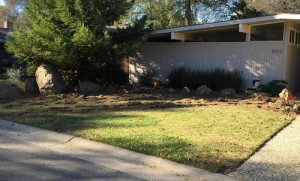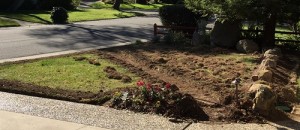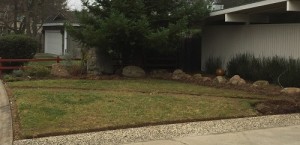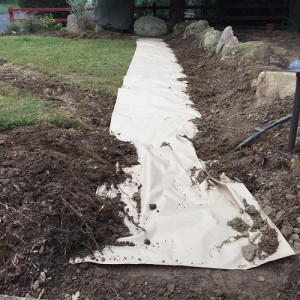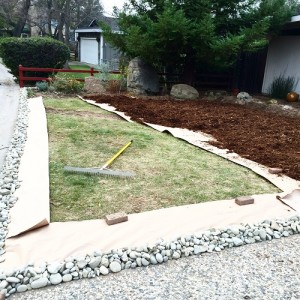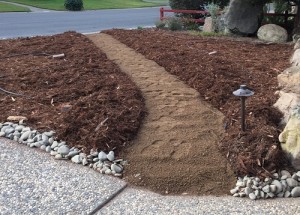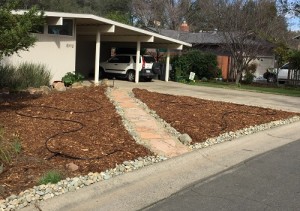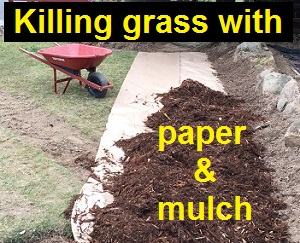
Smothering grass to reduce maintenance and water.
In the winter of 2015 the time had come for me to make my front yard grass disappear. After researching various labor intensive methods of removing turf, I finally settled on smothering the grass with wrapping paper and shredded cedar mulch. While this isn’t a full proof method, killing the grass in place is my preference to alternatives where all the turf is ripped out and new dirt brought in to replace it.
Winter flood triggers drought tolerant landscaping
It was an ironic set of events that led me to determine the easiest way to make my front yard grass vanish was to smother it with wrapping paper and mulch. A deluge of rain in early December 2014 created a raging torrent of water along the side of our house. (See: Granite Bay Floods) A good portion of the wood chips surrounding our raised garden beds were deposited on the back yard grass. When I finally got around to raking the three inches of chips off the turf a month later I noticed all the grass was dead underneath.
Plastic is for landfills
I’ve wanted to get rid of the grass in the front yard for years but the prospect of the time, energy and money to create a grass-less landscape was a big hurdle. My other aversion was using weed fabric or plastic to prevent grass from regenerating. I’m tired of putting plastic in the ground. I figured there had to be a way around blanketing my yard in plastic that will never go away, is a nuisance when you want to dig, and never seems to live up to its design.
Wrapping up my grass in paper
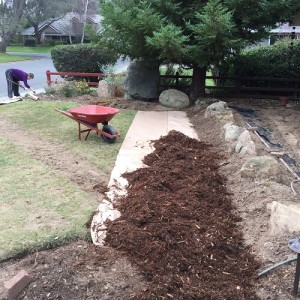
We covered the paper with the shredded cedar as we advanced down the front yard.
Perhaps the best method I had read about for killing grass was laying down sheets of cardboard. The only downside is collecting the cardboard and storing it until you are ready to use it. Then I read about this company selling paper as a weed suppressant in between garden rows. Since my front yard had become one giant weed, I figured I could use the paper along with a layer of mulch to smother my grass. More pictures at end of blog post.
Smothering the grass with mulch
I know that the wrapping paper and mulch is not a perfect solution for killing all the grass. Most likely I’ll probably have to patch some areas where grass does break through with more paper or cardboard. There is always the option of spot treating a few areas with grass killing herbicide. However, this is California and there is no summer rain. Any grass that does grow will die for lack of water by June or July. In addition, our experience with a thick layer of mulch is that most all broad leaf weeds will be discouraged from growing.
Rock perimeter to contain mulch
From prior experience with Bermuda grass and shredded cedar mulch I knew that boundary where the yard meets either the sidewalk or driveway was always problem area. In an effort to suppress grass from growing next to the concrete and the mulch from spilling onto walkways, we decided to create a rock border at that interface. I cut a small trench, 4 inch depth by 6 inch width, around the perimeter that we filled with one inch to two inch diameter river cobble. I also excavated a swath of grass that would become a pathway through the front yard.
Biodegradable paper to kill the grass
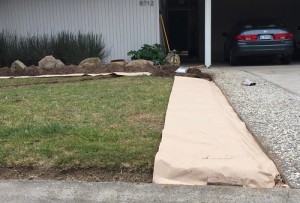
Kraft wrapping paper was folded into perimeter trench that would be filled with round river cobble rock.
Even after digging out the pathway and the perimeter for the rock, there was still eighty percent of the grass left in place. The turf area that needed wrapping paper and mulch was approximate 600 square feet. The specialty roll of paper weed suppressant for home gardens seemed a little expensive from online retailers. I checked at my local office supply store and found similar rolls of wrapping paper for less cost. I actually cleaned out the supplies of a couple different stores that had different brands of wrapping paper. The best value was the kraft postal wrap from Office Depot. It is heavy duty 60 pound paper that came in a roll of 24 inches by fifty feet. The kraft postal wrap withstood the numerous crossing across the paper as I dumped the shredded cedar without tearing like another light weight brand I bought.
I should have ordered more shredded cedar
I ordered enough shredded cedar to cover the grass area to a depth of three to four inches. When that was delivered we started rolling out the paper and dumping the shredded cedar to keep it in place. The perimeter cobble rock was delivered at the same time and we placed that material in the little perimeter trench I made. The biggest issue I ran into was the excavated pathway area. Because the yard was no longer flat, the paper would sometimes tear or move out of place at the edge of the excavated pathway dirt.
Double layer paper is possible
I probably should have doubled up on the paper at certain locations. Once it gets moist the paper will get small tears allowing the grass to peak
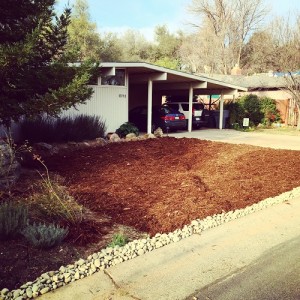
Front covered in shredded cedar and rock smothering the existing grass before we installed the pathway.
through. And because I scrimped on the shredded cedar mulch, it is not as thick as it should be to prevent light from getting to the ground. However, a month into the smothering and I’ve only noticed one area where the grass as popped up through a tear in the paper. I overlapped the runs of paper by three to four inches. In hindsight, I also should have double layered the paper as well.
I anticipate some grass popping up
A couple of weeks after we installed the smothering wrapping paper and shredded cedar we put in the pathway. If I had to do it over I would install the pathway with the decomposed granite and Arizona flagstone before the smothering mulch. I’m concerned that all the foot traffic over the mulched area created more rips in the wrapping paper. I fully anticipate fighting some grass, especially Bermuda, which will pop through the paper and shredded cedar.
Time and lack of water is the real grass killer
A downside of smothering the grass with paper is that you have to wait for it to sufficiently die before opening up the ground for new plants. With plastic or woven weed barrier you can plant even before the grass dies if you haven’t removed it. Eventually we’ll plant some drought tolerant shrubs but if I do it too soon, the opening will give the grass an opportunity to invade around the shrub. My third line of defense for killing the grass is the California Central Valley summer heat. With no water there will be no grass or weeds. If I’m judicious with the drip emitters at the new shrubs and heap on plenty of shredded cedar, I don’t suspect I’ll see any green grass in the front yard for years to come.
Project timeline
I started preparing the front yard for the paper and mulch in early January 2015. We finished with everything you see in the pictures below by early February. I remember laying the Arizona flagstone during the Super Bowl. In the middle of preparing the yard, I capped off all the pop-up spray sprinklers and added a line of drip tubing to water future drought tolerant plants. Before and after pictures below.
Cover and smother grass killing update
A couple months after we covered and smothered our grass with wrapping paper and shredded cedar it was time to add some drought tolerant plants. In between the time we initially covered the grass and the time we decided we needed to plant we had some good rain fall. This kept the soil moist and also allowed the Bermuda grass and sedge to keep growing. Much to my chagrin, I had to patrol the covered turf area and spray herbicide to kill the sprouts.
While I think a thick layer of cardboard would have helped suppress the Bermuda grass even better than just the paper, the tenacious nature of Bermuda probably would have found a way to break through to the surface. When we did pull back the shredded car mulch to dig the planting holes the paper had completely decomposed. Because the Bermuda is so pernicious and each plant was to have a drip emitter, I did give in and ring the planting hole with weed fabric.
A couple weeks after planting the drought tolerant plants they are growing and thriving as of June 4th. Of course, we haven’t had any scorching 100 degree plus days so far this spring. Overall, I think the plants will grow into nice front yard ornamentals and use less than 10% of the water the turf grass used to consume.
Drought tolerant planting
Original installation
Click on image to enlarge


